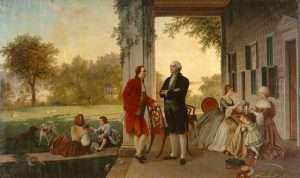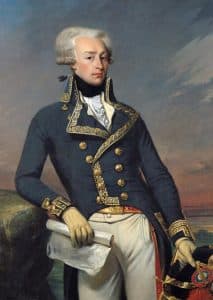| The American Revolution Story : Benjamin Franklin, George Washington, and Marquis de Lafayette |
As a cornerstone in world history, the American Revolution stands for the birth of a new nation and challenging the established norms of monarchy and colonial rule. At the heart of this revolutionary saga are the remarkable individuals who shaped its course, among them, Benjamin Franklin, George Washington, and marquis de la Fayette. Their contributions, leadership, and collaborative efforts played pivotal roles in securing America’s independence from British rule.
A Personalized Journey with PARIS BY EMY
Explore the fascinating story of Ben Franklin in Paris with a personalized tour designed just for you—no preset setting or already-made itinerary, just an experience tailored to your interests. Franklin played an important role in the relationship between Colonial America and the British government, shaping the future of the American colonies.
From his experiments with electrical phenomena—including the famous kite with a key attached—to his work as deputy postmaster general, Franklin’s legacy is everywhere. Franklin wrote for the Pennsylvania Gazette, published Poor Richard’s Almanack under the pen name Richard Saunders, and even started the first German-language newspaper in America.
His time in Paris was crucial in securing support for the American Revolution. Franklin proposed diplomatic strategies, argued against the Stamp Act, and negotiated on behalf of the Pennsylvania Assembly and the American government. He was awarded an honorary degree, became an influential thinker in political circles, and engaged with Junto members and French intellectuals.
This tour will take you through Franklin’s Paris, exploring his life from young Franklin—who left Boston to find work—to the diplomat who helped change history. Learn about Franklin’s son, William Franklin, his illegitimate son, and how Deborah Franklin’s death affected him.
With PARIS BY EMY, dive into Franklin’s life in Paris, from his friendships with the Penn family to his subscription library projects. Whether you’re interested in his modest enquiry into science, his time as postmaster general, or his role in the Albany Plan, this private guided tour will bring Franklin’s Paris to life—an experience we highly recommend!
Benjamin Franklin (1710-1790) : The Renaissance Man
Early Life and Career of Benjamin Franklin
Benjamin Franklin, a polymath and Founding Father of the United States, began his journey as a printer’s apprentice and rose to prominence through his entrepreneurial ventures and intellectual pursuits. His insatiable curiosity and passion for knowledge fueled his diverse interests, ranging from science and literature to diplomacy and politics.
In addition to his activities as a printer and politician, Benjamin Franklin is also known for his scientific research work, particularly in the field of electricity. We owe him common terms like battery, negative, load, condenser… He is also the inventor of the lightning rod.
Benjamin Franklin’s Contributions to the American Revolution
Franklin served from 1776 to 1778 on a commission to France charged with the critical task of gaining French support for American independence. French aristocrats and intellectuals embraced Franklin as the personification of the New World Enlightenment.
Franklin’s diplomatic acumen was instrumental in garnering crucial support from France, a key ally in the American struggle for independence. His negotiations secured vital aid, including military assistance and financial backing, which proved pivotal in tipping the scales in favor of the American cause.
Benjamin Franklin also participated in the drafting of the American Constitution. He thus became the only “founding father of America” to sign the three founding documents of the United States: the Treaty of Paris (1783) and the American Constitution (1787), the Declaration of Independence. The Continental Congress adopted the Declaration of Independence on July 4, 1776. It was engrossed on parchment and on August 2, 1776, delegates began signing it.
Thomas Jefferson was appointed to develop a Declaration of Independence first draft. He was the main author of the text on June 21, 1776 and submitted it to the committee which made some modifications. The committee of 5 representatives consisted of John Adams, Roger Sherman, Benjamin Franklin, Robert Livingston and Thomas Jefferson.

Washington and Lafayette at Mount Vernon, 1784 by Rossiter and Mignot, 1859 – Metropolitan Museum of Art
George Washington (1732-1799) : The Commander-in-Chief
Background and Rise to Leadership
George Washington, revered as the “Father of His Country,” emerged as a beacon of leadership during the turbulent years of the Revolution. His military prowess and unwavering resolve galvanized the fledgling nation, earning him the respect and admiration of his peers.
Key Role in the Revolution
As Commander-in-Chief of the Continental Army, Washington navigated through formidable challenges, from logistical hurdles to morale crises. His strategic brilliance and steadfast commitment to the cause inspired hope and resilience among his troops, culminating in decisive victories that shaped the course of the war.

Portrait of Gilbert du Motier, Marquis de Lafayette (1792) by Joseph Desire Court – Versailles Museum
Marquis de Lafayette (1757-1834) : The French Connection
Background and Motivation
Marquis de La Fayette, a young French nobleman inspired by the ideals of liberty and equality, volunteered to fight alongside the American rebels. His passionate commitment to the cause endeared him to Washington and earned him a prominent role in the Revolution.
Lafayette’s Impact on the Revolution
La Fayette’s military expertise and unwavering dedication bolstered the American forces, earning him a reputation as a valiant and strategic commander. His pivotal role in pivotal battles, such as the Siege of Yorktown, proved instrumental in securing American victory and solidifying Franco-American relations.
Benjamin Franklin, George Washington, and Lafayette : The Uniting Force
Strategic Partnerships
The alliance between America and France forged a formidable coalition against British forces, leveraging complementary strengths and resources to achieve shared objectives. This strategic partnership exemplified the power of collaboration in confronting tyranny and advancing the cause of liberty.
Coordination and Communication
Effective communication and coordination among key leaders, including Benjamin Franklin, Georges Washington, and the Marquis de Lafayette, were critical in aligning military strategies and diplomatic efforts. Their ability to navigate complex political landscapes and forge consensus laid the groundwork for unified action and strategic victories.
Pivotal Moments in the Revolution
Key Battles and Events
From the iconic battles of Lexington and Concord to the decisive showdown at Yorktown, the American Revolution was marked by a series of pivotal moments that tested the resolve and resilience of the patriots. These turning points shaped the trajectory of the war and ultimately led to American independence.
Benjamin Franklin’s Impact on the Outcome
The triumph of the American Revolution reverberated far beyond the shores of the fledgling nation, inspiring similar movements for freedom and self-determination around the world. The defeat of the British Empire signaled a seismic shift in global power dynamics and laid the foundation for the emergence of the United States as a beacon of democracy.
Legacy of the American Revolution
Global Influence thanks to Benjamin Franklin, Washington, and Lafayette
The ideals of liberty, democracy, and human rights espoused during the American Revolution ignited a spark of revolution that spread across continents, from Europe to Latin America. The legacy of America’s struggle for independence continues to inspire movements for social justice and democratic reform worldwide.
Lessons Learned of freedom thanks to Benjamin Franklin
The American Revolution serves as a testament to the power of resilience, unity, and collective action in the face of oppression and adversity. Its legacy reminds us of the enduring value of freedom and democracy and the sacrifices required to uphold these principles.
The American Revolution Story: Benjamin Franklin, Washington, and Lafayette
Benjamin Franklin is undoubtedly one of the most illustrious and influential figures in American history. This man of science and letters, close to the people, embodied the values of justice, work and fairness.
The story of the American Revolution is a testament to the indomitable spirit of those who dared to defy tyranny and forge a new path towards liberty and self-governance. Through the leadership of visionaries like Benjamin Franklin, George Washington, and Marquis de la Fayette, the American people rose to challenge the mightiest empire of their time and emerged victorious, for a nation founded on principles of freedom and equality.
Benjamin Franklin in Paris
Living in the Suburb of Paris
The Hôtel de Valentinois (at that time the property of Monsieur de Chaumont) in Passy was the home of Benjamin Franklin during the 9 years that he lived in France during the American Revolutionary War, when he represented American interests and sought French support for American independence.
Rue Raynouard and rue Singer angle – Hotel de Valentinois
On this site stood a vast property in the 18th century including an elegant private mansion, the Hôtel de Valentinois, located in a park of approximately four hectares. This is where Benjamin Franklin, who was special representative and then the first Ambassador in the history of the United States to France, lived from 1777 to 1785.
Benjamin Franklin left Philadelphia for France on October 26, 1776
Benjamin Franklin, aged 71 with his 2 grandsons, William Temple Franklin and Benjamin Franklin Bache, left Philadelphia for France on October 26, 1776, 3 months after the Declaration of Independence of the States (July 4, 1776). Franklin was mandated by the Continental Congress to obtain the financial, logistical and diplomatic support of King Louis XVI for the War of Independence against the crown of England.
On December 4, 1776, his ship docked in the small port of Saint-Goustan, in Auray, in Brittany. On December 21, 1776, he was in Paris. He first stayed at the Hôtel d’Entragues, 2, rue de l’Université, until January 8, 1777, then at the Hôtel de Hamburg, 52, rue Jacob, until the end of February.
Franklin was then invited by the Frenchman Jacques-Donatien Le Ray de Chaumont, shipowner and merchant, one of the richest and most powerful aristocrats in the kingdom. He was also a supporter of the cause of the American Insurgents, to stay free of charge at his residence in Passy.
The village of Passy was then a destination sought after by foreign diplomats, slightly outside Paris on the road to Versailles. Benjamin Franklin therefore settled in the small pavilion of the Hôtel de Valentinois, with his two grandsons who assisted him in his secretariat. He installed a printing press in another building, allowing him to have his own printing press.
Benjamin Franklin’s visitors in Paris
Benjamin Franklin received many visitors in Passy: Turgot, Buffon, d’Alembert, Condorcet, Malesherbes, La Rochefoucauld, Mirabeau, and Beaumarchais, responsible for conveying financial aid to the American Insurgents. It was also in Passy that Franklin met the young Marquis de La Fayette, before his departure for America.
However, the greatest success of Benjamin Franklin’s diplomatic work was the signing, on February 6, 1778, at the Hôtel de Coislin, of the Treaties of Friendship, Commerce and Alliance between France and the United States.
Benjamin Franklin left Paris, in July 1785 to return to the United States. He received as a gift the portrait of the King of France Louis XVI. The frame studded with 408 diamonds.
Emy,
As a Paris Trip Planner, PARIS BY EMY creates bespoke Paris Trip with personalized Paris Tour Package. It includes custom-made Paris private tour guide, tailor-made full stay itinerary…
Indeed, within a fabulous Parisian, we offer many services. Private driver services including driving tour in Normandy, the region of Champagne… Parisian restaurant and hotel recommendations… and so much more.
FAQs Benjamin Franklin, Washington, and Lafayette
How did Benjamin Franklin contribute to the American Revolution?
Benjamin Franklin played a crucial role in securing support from France. He negotiated key alliances and securing vital aid for the American cause.
What was George Washington’s significance in the Revolution?
George Washington’s leadership as Commander-in-Chief of the Continental Army was instrumental in rallying the American forces and securing pivotal victories.
Why was Marquis de Lafayette important to the Revolution?
Marquis de Lafayette’s military expertise and unwavering dedication bolstered the American forces. He is earning a reputation as a valiant and strategic commander.
What were some key turning points in the American Revolution?
Key turning points in the Revolution included the battles of Lexington and Concord. In addition, the Declaration of Independence, and the Siege of Yorktown.
What is the legacy of the American Revolution?
The American Revolution’s legacy includes its influence on global movements for freedom and democracy. Its enduring impact on American society and governance also are his legacy.

